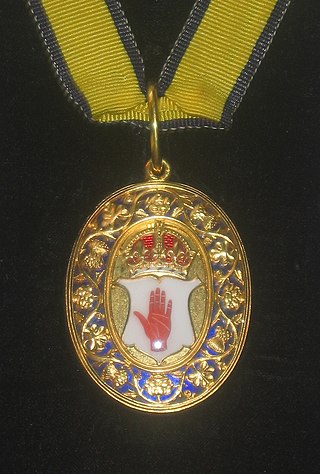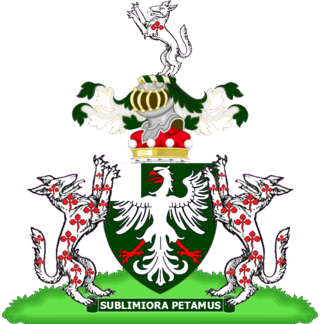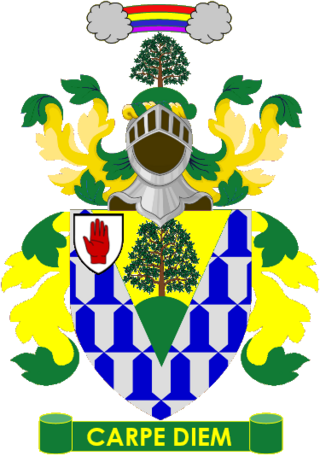
A baronet or the female equivalent, a baronetess, is the holder of a baronetcy, a hereditary title awarded by the British Crown. The title of baronet is mentioned as early as the 14th century; however, in its current usage it was created by James I of England in 1611 as a means of raising funds for the crown.

Baron Hazlerigg, of Noseley in the County of Leicester, is a title in the Peerage of the United Kingdom. It was created in 1945 for Sir Arthur Hazlerigg, 13th Baronet. He had previously served as Lord Lieutenant of Leicestershire. As of 2022 the titles are held by his grandson, the third Baron, who succeeded his father in that year.

Baron St Levan, of St Michael's Mount in the County of Cornwall, is a title in the Peerage of the United Kingdom. It was created on 4 July 1887 for the former Member of Parliament Sir John St Aubyn, 2nd Baronet, becoming John St Aubyn, 1st Baron St Levan. He had previously represented Cornwall West in House of Commons as a Liberal and St Ives as a Liberal Unionist. He was succeeded by his eldest son, the second Baron, who was a Colonel and Honorary Brigadier-General in the Grenadier Guards. On his death the titles passed to his nephew, the third Baron, the son of the Hon. Sir Arthur James Dudley Stuart St Aubyn (1867–1897), second son of the first Baron. The third baron was succeeded in 1978 by his eldest son, the fourth baron, who had served with the Royal Navy at Dunkirk and in a minesweeper in Arctic Convoys during World War II and was awarded the Distinguished Service Cross (DSC). As of 2014, the titles are held by the fourth Baron's nephew, the fifth Baron, who succeeded in 2013.

Baron Moncreiff, of Tulliebole in the County of Kinross, is a title in the Peerage of the United Kingdom. It was created on 9 January 1874 for the lawyer and Liberal politician Sir James Moncreiff, 1st Baronet. He had already been created a Baronet, of Kilduff in the County of Kinross, in the Baronetage of the United Kingdom on 23 May 1871. In 1883 Lord Moncreiff also succeeded his elder brother as 11th Baronet, of Moncreiff in the County of Perth. On his death the titles passed to his eldest son, the second Baron. He was a Judge of the Court of Session from 1888 to 1905 under the title of Lord Wellwood and served as Lord Lieutenant of Kinross-shire between 1901 and 1909. He was succeeded by his younger brother, the third Baron. He was a clergyman. As of 2010 the titles are held by the latter's great-grandson, the sixth Baron, who succeeded his father in 2002.

Baron Biddulph, of Ledbury in the County of Hereford, is a title in the Peerage of the United Kingdom. It was created on 1 August 1903 for the banker and politician Michael Biddulph. He was a partner in the London banking firm of Cocks, Biddulph and Co and also sat in the House of Commons for Herefordshire as a Liberal from 1868 to 1885 and for Ross from 1885 to 1900 as a Liberal Unionist. His father Robert Biddulph had previously represented Hereford in Parliament while his younger brother Sir Robert Biddulph was Governor of Gibraltar. As of 2017 the title is held by the first Baron's great-great-grandson, the fifth Baron, who succeeded his father in 1988. In 1978 he assumed the additional surname of Maitland, which is the maiden surname of his mother, Lady Mary Helena Maitland, granddaughter of Ian Colin Maitland, 15th Earl of Lauderdale. She is a Patroness of the Royal Caledonian Ball.

Baron Croft, of Bournemouth in the County of Southampton, is a title in the Peerage of the United Kingdom. It was created on 28 May 1940 for the Conservative politician Sir Henry Page Croft, 1st Baronet. He had already been created a baronet of Knole in the Borough of Bournemouth in the County of Southampton in the Baronetage of the United Kingdom on 28 February 1924. Croft was the grandson of Reverend Richard Croft, third son of Dr. Sir Richard Croft, 6th Baronet, of Croft Castle. As of 2010 the titles are held by the first Baron's grandson, the third Baron, who succeeded his father in 1997.
Baron Leighton of St Mellons, of St Mellons in the County of Monmouth, is a title in the Peerage of the United Kingdom. It was created on 25 January 1962 for the Welsh shipping magnate Sir Leighton Seager, 1st Baronet. He was the son of Sir William Henry Seager. Seager had already been created a Baronet, of St Mellons in the County of Monmouth on 1 July 1952. As of 2017 the titles are held by his grandson, the third Baron, who succeeded his father in 1998. As of 31 December 2016 the present Baronet has not successfully proven his succession and is therefore not on the Official Roll of the Baronetage, with the baronetcy considered dormant since 1998.
There have been 18 baronetcies created for persons with the surname Campbell, six in the Baronetage of Nova Scotia and twelve in the Baronetage of the United Kingdom.
There have been three baronetcies created for members of the Anstruther family, two in the Baronetage of Nova Scotia and one in the Baronetage of Great Britain. Two of the creations are extant while one is extinct.
The Lowson baronetcy, of Westlaws in the County of Perth, is a title in the Baronetage of the United Kingdom.

The Wigan Baronetcy, of Clare Lawn in Mortlake in the County of Surrey and Purland Chase in Ross in the County of Hereford, is a title in the Baronetage of the United Kingdom. It was created on 9 March 1898 for Frederick Wigan, a Director of the North London Railway. The presumed 6th Baronet, listed in Debrett's Peerage (2015) as the son of the 5th Baronet, has not successfully proven his succession and is consequently not on the Official Roll of the Baronetage.

There have been twenty one baronetcies created for persons with the surname Williams, eight in the Baronetage of England, three in the Baronetage of Great Britain and ten in the Baronetage of the United Kingdom. Only six of the creations are extant as of 2017.
There have been three baronetcies created for persons with the surname Everard, one in the Baronetage of Ireland, one in the Baronetage of England and one in the Baronetage of the United Kingdom. Only one creation is extant as of 2010.
There have been four baronetcies created for persons with the surname O'Brien, one in the Baronetage of Ireland and three in the Baronetage of the United Kingdom.

Sir Broderick Chinnery, 1st Baronet, was an Irish politician and baronet.
The Hartstonge Baronetcy, of Bruff in the County of Limerick, was a title in the Baronetage of Ireland. It was created on 20 April 1681 for Standish Hartstonge, an English-born judge who sat on the Irish Court of Exchequer, and who had inherited estates at Bruff from his mother's family, the Standishes. The second Baronet, his grandson, was a member of the Irish House of Commons for Kilmallock, Ratoath and St Canice. The third Baronet was a member of the Irish Parliament for County Limerick. The title became extinct on his death in 1797, when the Hartstonge estates passed by inheritance to the Earl of Limerick.
The High Sheriff of County Waterford was the Sovereign's judicial representative in County Waterford. Initially, an office for a lifetime, assigned by the Sovereign, the High Sheriff became an annual appointment following the Provisions of Oxford in 1258. Besides his judicial importance, the sheriff had ceremonial and administrative functions and executed High Court Writs.
The Sheriff of County Dublin was the Sovereign's judicial representative in County Dublin. Initially, an office for a lifetime, assigned by the Sovereign, the Sheriff became an annual appointment following the Provisions of Oxford in 1258. The first recorded Sheriff was Ralph Eure, appointed in that year. The next recorded Sheriff was Sir David de Offington, who was Sheriff in 1282. Besides his judicial importance, the sheriff had ceremonial and administrative functions and executed High Court Writs.
Sir Paul Davys was an Irish politician and civil servant, who held office as Clerk to the Privy Council of Ireland and later as Secretary of State (Ireland). He had considerable influence in public affairs, and enjoyed the close friendship of the Lord Lieutenant, James Butler, 1st Duke of Ormonde. His sons, William and John, both attained high office. He was the grandfather of Paul Davys, 1st Viscount Mount Cashell.